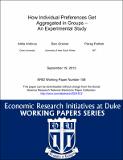How individual preferences are aggregated in groups: An experimental study
Author(s)
Ambrus, Attila; Greiner, Ben; Pathak, Parag
DownloadPathak_How individual.pdf (345.9Kb)
PUBLISHER_CC
Publisher with Creative Commons License
Creative Commons Attribution
Terms of use
Metadata
Show full item recordAbstract
This paper experimentally investigates how individual preferences, through unrestricted deliberation, are aggregated into a group decision in two contexts: reciprocating gifts and choosing between lotteries. In both contexts, we find that median group members have a significant impact on the group decision, but the median is not the only influential group member. Non-median members closer to the median tend to have more influence than other members. By investigating the same individual's influence in different groups, we find evidence for relative position in the group having a direct effect on influence. These results are consistent with predictions from spatial models of dynamic bargaining, for members with intermediate levels of patience. We also find that group deliberation involves bargaining and compromise as well as persuasion: preferences tend to shift towards the choice of the individual's previous group, especially for those with extreme individual preferences. Keywords: Group decision-making; Role of deliberation; Social influence
Date issued
2015-06Department
Massachusetts Institute of Technology. Department of EconomicsJournal
Journal of Public Economics
Publisher
Elsevier BV
Citation
Ambrus, Attila et al. “How Individual Preferences Are Aggregated in Groups: An Experimental Study.” Journal of Public Economics 129 (September 2015): 1–13 © 2015 Elsevier B.V.
Version: Original manuscript
ISSN
0047-2727
1879-2316